Arsenic is a potent carcinogen and one of the world’s most dangerous drinking-water contaminants, particularly in South Asia, where millions are exposed through groundwater. Removing the toxin from groundwater helps protect public health but leaves behind sludge laced with arsenic, which is expensive and hazardous to dispose of properly.
Researchers in Denmark have now found a way to turn that toxic waste into something valuable: high-purity elemental arsenic, a material in growing demand for green electronics and batteries (Sci. Adv. 2025, DOI:10.1126/sciadv.adz5816).
Most water treatment plants remove arsenic from groundwater by adding iron ions that oxidize in the water and turn to rust. These rust particles bind to arsenic and eventually settle into a dense, reddish sludge at the bottom of treatment tanks. This waste is rich in arsenic and phosphorus, which are chemically bound to the surfaces of the rust particles.
Two bottles, one filled with red sludge and the other with black metal suspension in a liquid.
Raw sludge produced from arsenic groundwater treatment (left) and the fully converted pure metallic arsenic suspension.
Credit:
GUES – The Geological Survey of Denmark and Greenland
Kaifeng Wang and Case van Genuchten at the Geological Survey of Denmark and Greenland recover the arsenic from this sludge by washing it with a concentrated alkaline solution. This process breaks the chemical bonds between arsenic, phosphate, and the iron oxides, releasing the arsenic and phosphate into the liquid. When the mixture is heated and treated with thiourea dioxide, the dissolved arsenic compounds are reduced to elemental arsenic, which separates as fine metallic particles. The phosphate remains dissolved and can be recovered separately by treatment with calcium.
“To my knowledge, directly converting arsenic-bearing waste from water treatment into pure metallic arsenic has not been demonstrated before,” says Tamara Etmannski, an environmental engineer at the University of British Columbia who was not involved in the study.
The process produces arsenic in an amorphous form rather than the usual crystalline metal, and that difference could be a plus. Amorphous arsenic is more chemically uniform and easier to handle; it forms stable powders that don’t oxidize or clump as readily as crystalline arsenic does. That stability makes it easier to store, transport, and use as a raw material. The amorphous form is also more reactive and easier to convert to other compounds or thin films, which could make it a better feedstock for producing electronic or optical materials.
Arsenic is considered a critical raw material in the European Union and the US, and most of the world’s supply comes from China. Meanwhile, water treatment plants worldwide spend heavily to dispose of arsenic-rich waste. “We have converted this contaminant into a commodity,” van Genuchten says.
The researchers did a life-cycle assessment showing that, even after accounting for the chemicals used, recovering arsenic this way is cleaner—both in terms of human toxicity and environmental impact—than mining new material or dumping the waste. The method is cost-efficient because it can also recover phosphate—potentially turning waste into a valuable product that offsets treatment costs.
The approach is still at the lab scale, and challenges remain in scaling up and recycling the reagents. “The main challenges would involve site-specific engineering constraints, such as space and integration with existing flow systems,” Etmannski says. “However, given the growing political and industrial momentum around critical raw materials recovery, the timing for innovations like this is excellent.”
If this technology could be deployed economically, it could turn water plants into small refineries, cleaning up a public health hazard while helping secure a supply of a critical element for green technology.
Chemical & Engineering News
ISSN 0009-2347
Copyright ©
2025 American Chemical Society

